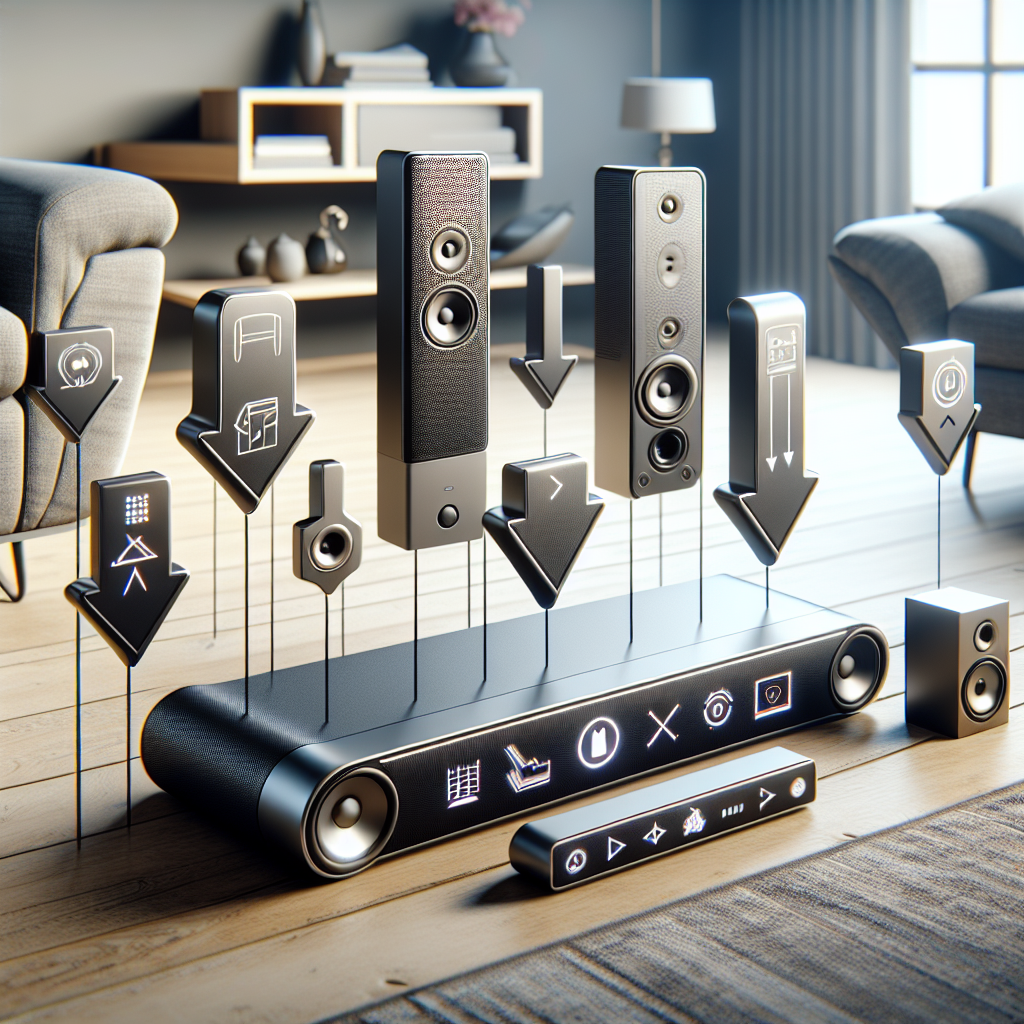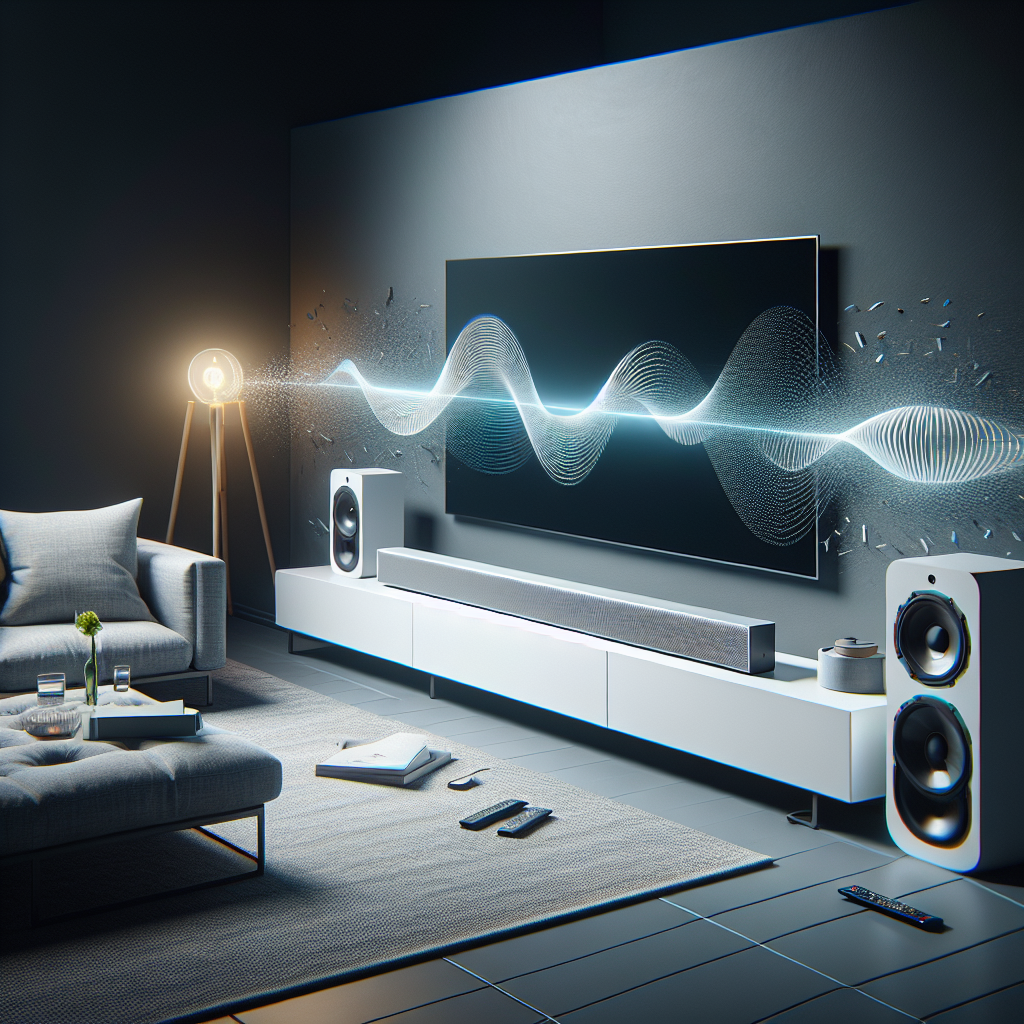Did you know that soundbars have become increasingly popular in recent years as a convenient alternative to traditional home theater speaker systems? If you’re in the market for a new audio setup, it’s important to consider the pros and cons of soundbars before making a decision. On one hand, soundbars take up less space and are easy to install, making them a great option for smaller rooms or those who value simplicity. However, they may not offer the same immersive sound experience as a full surround sound system. In this article, we’ll explore the advantages and disadvantages of soundbars to help you determine if they are the right choice for your entertainment needs.
Pros of Soundbars
Improved audio quality
One of the biggest advantages of using a soundbar is the improved audio quality it provides. Soundbars are specially designed to enhance the audio experience and deliver sound that is clearer, more immersive, and more balanced. Whether you’re watching movies, playing games, or listening to music, a soundbar can greatly enhance the overall quality of the sound.
Space-saving design
If you’re looking to save space in your living room or entertainment area, a soundbar is the perfect choice. Unlike traditional home theater systems that require multiple bulky speakers, a soundbar is a compact and sleek device that can easily fit under or in front of your TV. This space-saving design allows you to enjoy high-quality audio without the need for additional speakers cluttering up your room.
Easy installation
Installing a soundbar is quick and easy, making it a convenient option for those who want hassle-free setup. With fewer wires and cables compared to traditional speaker systems, you can hook up your soundbar to your TV in no time. Many soundbars also come with a simple setup process, requiring minimal adjustments to get the audio just right.
Convenient control options
Soundbars offer a variety of control options that make operating them a breeze. Most soundbars can be integrated with your TV remote, allowing you to adjust the volume or change settings without the need for an additional remote. Some soundbars also come with wireless control options, allowing you to control the audio from your smartphone or tablet. Additionally, voice control features are becoming increasingly popular, giving you hands-free control over your soundbar.
Enhanced television sound
One of the main reasons people invest in a soundbar is to improve the sound quality of their television. Soundbars are designed to amplify volume levels, enhance clarity, reduce distortion, and provide a better overall viewing experience. Whether you’re watching your favorite TV shows, movies, or sports games, a soundbar can significantly enhance the sound coming from your TV, making it more immersive and enjoyable.
Versatile connectivity options
Soundbars offer a range of connectivity options, giving you the flexibility to connect them to various devices. Bluetooth connectivity allows you to wirelessly stream music from your smartphone or tablet directly to the soundbar. HDMI ARC compatibility allows for easy connection to your TV using a single HDMI cable. Optical and coaxial inputs provide alternatives for connecting to different audio sources. With such versatile connectivity options, you can easily integrate your soundbar into your existing entertainment setup.
Cons of Soundbars
Limited surround sound experience
While soundbars do provide improved audio quality, they often fall short in delivering a true surround sound experience. Traditional home theater systems with physical rear speakers can create a more immersive audio environment, with sound coming from various directions. Soundbars, on the other hand, typically use virtual surround sound technology, which tries to replicate the surround sound experience through psychoacoustic algorithms. While this can enhance the audio, it may not match the level of immersion provided by dedicated rear speakers.
Lack of physical rear speakers
One of the limitations of soundbars is that they lack physical rear speakers. Rear speakers are crucial for creating a true surround sound experience by dispersing sound behind the viewer. Soundbars often rely on sound projection and bouncing techniques to simulate surround sound, but without physical rear speakers, the effect may be diminished. This limitation can be particularly noticeable in large rooms or spaces where the distance between the viewer and the soundbar is significant.
Inconsistent sound distribution
Another drawback of soundbars is the potential for inconsistent sound distribution. The positioning of the soundbar, the layout of the room, and other objects can affect how the sound is dispersed. If the soundbar is not placed correctly or if there are obstacles in the way, the audio experience may be compromised. It’s important to carefully consider the placement of the soundbar in order to optimize the sound distribution and ensure an enjoyable listening experience.
May not fit all TV sizes
While soundbars are designed to be sleek and space-saving, they may not be suitable for all TV sizes. Some soundbars are specifically designed to pair with TVs of certain dimensions, and using a soundbar that is too small or too large for your TV may result in an unbalanced aesthetic. Before purchasing a soundbar, it’s essential to check the compatibility with your TV size to ensure a proper fit and a visually pleasing setup.
Additional cost
Investing in a soundbar comes with an additional cost compared to using the built-in speakers of your TV. While soundbars can greatly enhance the audio experience, their prices can range from relatively affordable to high-end, depending on the brand, features, and sound quality. It’s important to consider your budget and prioritize your audio needs when choosing a soundbar that fits your requirements.
Potential compatibility issues
Soundbars, like any electronic device, can have compatibility issues with certain TVs or audio formats. Connectivity problems may arise with older TVs that lack modern ports or compatibility with the soundbar’s connection options. Additionally, software updates for the soundbar or compatibility with specific audio formats may affect its performance. It’s advisable to research and ensure compatibility between your TV, soundbar, and audio sources to avoid any potential compatibility issues.

Improved Audio Quality
Clearer dialogue
One of the key audio improvements offered by soundbars is clearer dialogue. Soundbars are designed to emphasize speech and make it more distinct, allowing you to understand dialogue without straining to hear it. This can greatly enhance your movie and TV show watching experience, ensuring that you catch every word spoken by the actors.
Enhanced sound effects
Soundbars are equipped with advanced audio technologies that excel in reproducing sound effects with greater clarity and precision. Whether it’s the sound of explosions, the swish of a sword, or the subtle rustling of leaves, a soundbar can bring these sound effects to life, allowing you to fully immerse yourself in the audio experience.
Better bass performance
Many soundbars come with built-in subwoofers or have the ability to connect with external subwoofers. This enhances the bass performance, providing a deep and rich low-end sound. The improved bass response not only provides a more immersive movie watching experience but also adds depth and richness to your music playback.
Virtual surround sound
To compensate for the lack of physical rear speakers, soundbars often utilize virtual surround sound technology. By strategically directing sound and utilizing psychoacoustic algorithms, soundbars create a virtual sound field that aims to replicate a surround sound experience. While it may not match the authenticity of true surround sound, virtual surround sound can still provide a more immersive audio experience compared to standard TV speakers.
Space-saving Design
Compact and sleek
One of the standout benefits of soundbars is their compact and sleek design. Unlike traditional home theater systems that require multiple speakers placed around the room, a soundbar is a single, elongated speaker that can easily fit under or in front of your TV. Its slim profile and minimalist design allow it to seamlessly blend into your entertainment setup without taking up much space.
No need for multiple bulky speakers
With a soundbar, there’s no need to clutter your living space with multiple bulky speakers. The all-in-one design of a soundbar eliminates the need for separate speakers for each audio channel. Instead, the soundbar incorporates multiple speakers within its slim casing, providing a streamlined and space-saving solution.
Ideal for small living spaces
For those living in apartments or small homes, space is often a premium. Soundbars are specifically designed to cater to such living spaces, offering a compact and efficient audio solution. Whether you have limited shelf space or want to keep your living area clean and uncluttered, a soundbar is an excellent choice for enhancing your audio experience without sacrificing room.

Easy Installation
Fewer wires and cables
Setting up a soundbar is significantly easier than dealing with a traditional home theater system. Unlike a surround sound speaker setup that requires running cables to each individual speaker, a soundbar typically requires only a single power cord and a connection to your TV. This significantly reduces cable clutter and makes the installation process much simpler.
Quick setup process
Soundbars are designed with ease of use in mind, and their setup process reflects that. Most soundbars come with straightforward installation instructions, allowing you to get your audio system up and running in no time. With just a few simple steps, you can connect your soundbar to your TV and start enjoying high-quality audio without any hassle.
Minimal adjustments required
Once your soundbar is set up and connected, there are usually minimal adjustments required to optimize the audio quality. Soundbars are designed to work well out of the box, providing a balanced sound profile that suits most listening environments. While more advanced users may want to tweak the settings to their preference, the default sound settings of a soundbar are typically sufficient for most users.
Convenient Control Options
Integrated with TV remote
Say goodbye to juggling multiple remotes when using a soundbar. Many soundbars can be seamlessly integrated with your TV remote, allowing you to control the soundbar’s volume and settings using the same remote you use for your TV. This eliminates the need for an additional remote and simplifies the control process.
Wireless control via smartphone or tablet
In addition to TV remote compatibility, many soundbars also offer wireless control options through your smartphone or tablet. By downloading the soundbar’s app and connecting it to your device, you can adjust the volume, switch inputs, and customize sound settings right from your fingertips. This wireless control feature adds convenience and flexibility to your soundbar experience.
Voice control features
With the rise of smart home devices, voice control has become an increasingly popular option in soundbars. Some soundbars are equipped with voice control capabilities, allowing you to control various functions using voice commands. Whether it’s adjusting the volume, changing inputs, or even asking for specific songs or playlists to be played, voice control features offer a hands-free and effortless way to control your soundbar.
Customizable sound settings
Soundbars often come with various sound modes and customizable settings to cater to different audio preferences. Whether you prefer a balanced sound, enhanced bass, or a more immersive audio experience, soundbars allow you to adjust the sound settings according to your liking. This customization gives you the flexibility to tailor the audio output to your taste and create an audio experience that suits your preferences.
Enhanced Television Sound
Amplified volume levels
One of the main advantages of using a soundbar with your TV is the ability to achieve higher volume levels. Soundbars are designed to provide enhanced amplification, allowing you to increase the volume without causing distortion or compromising sound quality. This is especially beneficial when watching action-packed movies or sports events, where the sound needs to be powerful and impactful.
Improved clarity
Soundbars excel at improving the clarity of the audio coming from your TV. Whether it’s dialogue in movies and TV shows or commentary during sporting events, a soundbar enhances the clarity, ensuring that every word is crystal clear. This improves the overall audio experience, making it easier to follow the storyline or understand the content being presented.
Reduced distortion
TV speakers often struggle with distortion, especially when playing high volumes or low-frequency sounds. Soundbars, on the other hand, are designed to handle a wider range of audio frequencies with minimal distortion. This results in cleaner, clearer sound reproduction, allowing you to enjoy your favorite movies and shows without the annoyance of distorted audio.
Better overall viewing experience
By providing improved audio quality, soundbars contribute to a better overall viewing experience. The combination of enhanced clarity, amplified volume, and reduced distortion creates a more immersive environment, allowing you to fully immerse yourself in the content you’re watching. Whether it’s a thrilling movie, an intense sports game, or a captivating TV show, a soundbar can elevate your viewing experience to new heights.
Versatile Connectivity Options
Bluetooth connectivity
Bluetooth connectivity is a popular feature found in many soundbars, enabling wireless audio streaming from your smartphone, tablet, or other compatible devices. With Bluetooth, you can easily play your favorite music, podcasts, or audiobooks through your soundbar without the need for any physical connections. This wireless capability provides convenience and flexibility, allowing you to enjoy your personal audio content effortlessly.
HDMI ARC compatibility
HDMI ARC (Audio Return Channel) is a useful feature that allows the soundbar to receive audio from your TV through a single HDMI cable. This eliminates the need for additional audio cables and simplifies the overall setup. HDMI ARC also enables you to control the soundbar’s volume and settings using your TV remote, further enhancing the convenience and integration of your audio system.
Optical and coaxial inputs
In addition to HDMI ARC, many soundbars also offer optical and coaxial inputs. These connections allow you to connect your soundbar to various audio sources, such as Blu-ray players, gaming consoles, or audio receivers. Optical and coaxial inputs provide an alternative to HDMI for devices that may not have HDMI output, ensuring compatibility with a wide range of audio sources.
Wireless streaming capabilities
Some soundbars go beyond Bluetooth connectivity and offer additional wireless streaming capabilities. These soundbars may support Wi-Fi connectivity, enabling seamless streaming from popular music services or even integrating with your home network for multi-room audio setups. Wireless streaming provides access to a vast library of music and audio content, expanding the versatility of your soundbar beyond traditional TV audio.
Limited Surround Sound Experience
Less immersive audio
While soundbars strive to provide a more immersive audio experience, they often fall short when compared to a full surround sound setup. The absence of dedicated rear speakers can result in a less enveloping soundstage, making it more difficult to perceive sounds coming from behind or creating a true three-dimensional audio experience. While soundbars can enhance the audio, they may not replicate the level of immersion that a dedicated surround sound system offers.
Not suitable for large rooms
Due to their design and the absence of physical rear speakers, soundbars may not be the ideal choice for large rooms or open floor plans. In larger spaces, the sound may not reach all areas evenly, resulting in an imbalanced listening experience. Additionally, the lack of rear speakers can diminish the sense of spaciousness and envelopment that surround sound systems provide. If you have a large living room or entertainment area, a soundbar may not be able to deliver the audio coverage you desire.
May lack depth and width
While virtual surround sound technology in soundbars can create the illusion of a wider soundstage, it may not fully replicate the depth and width provided by dedicated rear speakers. The perception of depth and width in audio is crucial for creating a truly immersive experience. While soundbars can provide a satisfactory audio experience for most content, they may not match the level of immersion provided by a full surround sound system.
Potential Compatibility Issues
Connectivity problems with older TVs
Older TVs may lack the necessary ports or compatibility with modern soundbar connections. For example, if your TV doesn’t have HDMI ARC or optical outputs, connecting a soundbar may require additional adapters or workarounds. It’s important to check the compatibility between your TV and the soundbar beforehand to ensure a smooth connection and avoid any frustrating connectivity issues.
Software updates and compatibility
Like any technology, soundbars may require software updates to improve performance, add new features, or fix any bugs or compatibility issues. However, software updates can sometimes be problematic if not properly managed. Compatibility issues may arise if the soundbar’s firmware is not compatible with your TV or other devices in your setup. Staying updated with the latest software releases and ensuring compatibility between devices can help prevent any potential issues.
Possible incompatibility with audio formats
Soundbars, especially those with advanced features or support for high-resolution audio, may encounter compatibility issues with certain audio formats. For example, if your soundbar supports Dolby Atmos, but your TV or audio source doesn’t, you may not be able to fully benefit from the immersive audio experience. It’s important to carefully review the audio formats supported by your soundbar and ensure compatibility with your existing audio sources before making a purchase.



